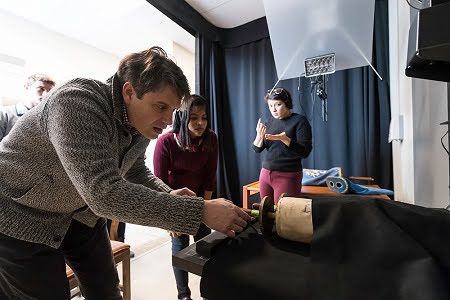A University of Rochester professor uses different wavelengths of light to photograph and analyze cultural artifacts using digital imagery to salvage objects, such as the Hebrew Torah, whose legibility has deteriorated over time.
Associate professor Gregory Heyworth, who calls his research specialty “textual science,” is the force behind the Lazarus Project, a multispectral imaging group and nonprofit organization he established to keep historical artifacts from being lost to time.

Professor Gregory Heyworth (left) and Pooja Priya, a student in his Digital Media Studies course, prepare Torah scrolls for imaging. The process involves photographing artifacts scores or even hundreds of times under different wavelengths of light. The best resulting images are then digitally stitched together to give a complete, enhanced picture of the object. Courtesy of University of Rochester/J. Adam Fenster.
But now, under the lights and the lens of a multispectral imaging
system, a Torah scroll brought to the university by Rochester alumna Carol
Holstein Killian and her husband, Ronald Killian, the letters on the
scroll are once again legible.
Under the red, blue, green, and orange lights in his lab, Heyworth is able to enhance deteriorated text by employing a process that involves photographing artifacts many times under different wavelengths. The best images are then digitally stitched together to give a more complete picture of the object.
Each Lazarus Project artifact is photographed under various ultraviolet wavelengths of light, because Heyworth never knows in advance what fluorescence band will provide the most revealing image of the object.
Most recently, Heyworth and his team have once again made legible the words on a Torah scroll dating to around 1900 that was among the Jewish religious books, liturgical objects, and records that were relinquished during the German invasion of Bohemia and Moravia in 1939. More than 200,000 items were held in Prague’s Jewish Museum, including almost 1800 Torah scrolls.
In the 1960s, the organization Memorial Scrolls Trust was established in London and began to purchase the scrolls, documenting and repairing them and then placing them with Jewish congregations around the world, creating a sacred, tangible link between them and the congregations lost to the Holocaust.